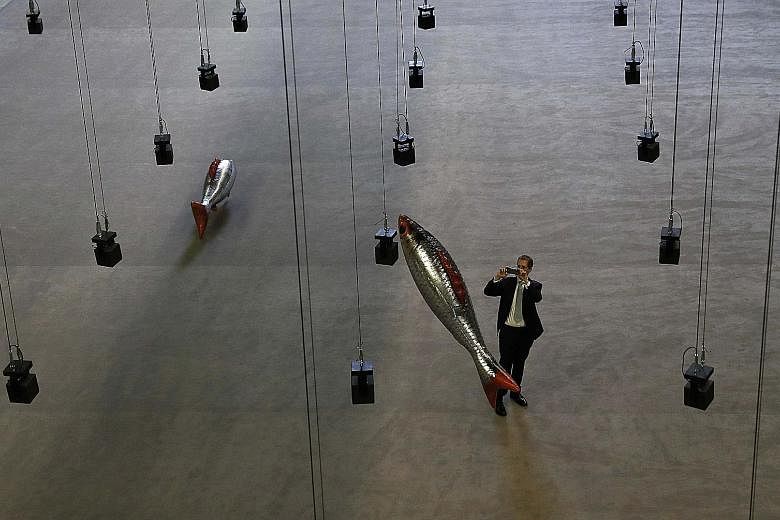LONDON • The directors of two of the world's most popular art museums recently announced their resignations.
Mr Martin Roth, director of the Victoria and Albert Museum (V&A), will step down this year and Mr Nicholas Serota of the Tate museums, both in Britain, will depart next year.
These job vacancies, which search committees are now working to fill, offer an opportunity to correct the gender imbalance in art museum leadership in Britain, the United States and beyond.
Last year, the world's top 12 art museums, as based on attendance, were led by men. When Ms Frances Morris became director of the Tate Modern last April, she became the first woman to join the club.
This gender gap extends from Europe to North America, where only five of the 33 directors of the most prominent museums - those with operating budgets exceeding US$20 million (S$27 million) - are women, including Ms Kaywin Feldman of the Minneapolis Institute of Art and Ms Nathalie Bondil of the Montreal Museum of Fine Arts. It is the leaders of those big-budget institutions who set the tone for all.
The top three art museums have never been run by a woman. The Louvre, the British Museum and the Metropolitan Museum of Art are treasure-filled, international destinations.
They are also big businesses, together attracting more than 20 million people a year. A large portion of these visitors are tourists who spend money at hotels and shops. Museums directly contribute US$21 billion a year to the American economy alone and far more, thanks to the indirect spending of their visitors.
Many women work as curators. In American art museums, about 70 per cent of curators are women; where I work, at the V&A, the figure is about 75 per cent.
Yet women remain scarce in the directorial roles. A 2014 report released by the Association of Art Museum Directors suggested that gender might not matter in selecting the best candidates, but that museum boards and their search committees, still predominantly male, may be appointing in their own image.
Much is at stake. Last year, 62 million people visited the world's top dozen art museums. In Britain, there are an estimated 97,000 jobs in museums, galleries and libraries, while 400,000 people are employed in American museums.
Executive recruitment at these institutions matters because the cultural sector has such influence. Museums and galleries frame the world for us: Senior managers decide what goes on the walls. This, in turn, shapes what the public values.
The male dominance in leadership at the directors' dozen helps to explain why so much of what is on display is man-made, rather than work by female artists.
Some women are challenging the gender bias of arts programming and partnerships. In the early 2000s, V&A's design director Moira Gemmill championed award-winning commissions from emerging female architects and artists.
At the Tate Modern, Ms Morris has voiced her desire to show more work by women; the current Georgia O'Keeffe exhibition hints at the new emphasis.
This month, the Elizabeth A. Sackler Center for Feminist Art at the Brooklyn Museum is presenting a Beverly Buchanan retrospective as part of its 10th anniversary.
Nearly three decades ago, a poster by the Guerrilla Girls, an activist group of female artists, asked: "Do women have to be naked to get into the Met Museum?" Their continuing protest against women's under- representation in museum collections still applies to museum leadership.
But there are reasons for optimism. Changing gender expectations have resulted in the emergence of a generation of female arts leaders. Outside the top 12, women are now running influential arts institutions such as the Studio Museum in Harlem and the Hammer Museum in Los Angeles.
The V&A became a pioneer in equal opportunity when it appointed Ms Elizabeth Esteve-Coll to be its director in 1987. Whatever its board members thought they were getting with Britain's first female leader of a national arts collection, I suspect their expectations were confounded. Her polarising tenure, which ended in 1995, included controversial crowd-pleasing shows, such as the one devoted to singer Elton John.
Her aim - to be "more popular without trivialising" - was radical at the time. Today, it seems in tune with the constant calls for cultural inclusion. What is undeniable with hindsight is that she showed the benefits of offering opportunities to a more diverse pool of talent.
As Ms Jude Kelly, artistic director of London's Southbank Center for performing arts, has said, being inclusive is not about "standing in the middle and saying, 'I'd like to include you.'" Instead, she said: "You have to stand in a different place."
NY TIMES
• The writer is a curator at the Victoria and Albert Museum.

